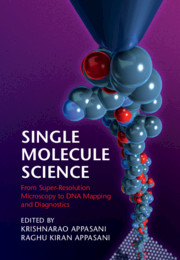108 results
Preface
-
- Book:
- Single-Molecule Science
- Published online:
- 05 May 2022
- Print publication:
- 26 May 2022, pp xix-xxii
-
- Chapter
- Export citation
Dedication
-
- Book:
- Single-Molecule Science
- Published online:
- 05 May 2022
- Print publication:
- 26 May 2022, pp v-vi
-
- Chapter
- Export citation
Copyright page
-
- Book:
- Single-Molecule Science
- Published online:
- 05 May 2022
- Print publication:
- 26 May 2022, pp iv-iv
-
- Chapter
- Export citation
Index
-
- Book:
- Single-Molecule Science
- Published online:
- 05 May 2022
- Print publication:
- 26 May 2022, pp 142-148
-
- Chapter
- Export citation
1 - Introduction on Single-Molecule Science
- from Part I - Super-Resolution Microscopy and Molecular Imaging Techniques to Probe Biology
-
-
- Book:
- Single-Molecule Science
- Published online:
- 05 May 2022
- Print publication:
- 26 May 2022, pp 3-19
-
- Chapter
- Export citation
Part III - Mapping DNA Molecules at the Single-Molecule Level
-
- Book:
- Single-Molecule Science
- Published online:
- 05 May 2022
- Print publication:
- 26 May 2022, pp 95-124
-
- Chapter
- Export citation
Contributors
-
- Book:
- Single-Molecule Science
- Published online:
- 05 May 2022
- Print publication:
- 26 May 2022, pp ix-xiii
-
- Chapter
- Export citation
Contents
-
- Book:
- Single-Molecule Science
- Published online:
- 05 May 2022
- Print publication:
- 26 May 2022, pp vii-viii
-
- Chapter
- Export citation
Foreword
-
- Book:
- Single-Molecule Science
- Published online:
- 05 May 2022
- Print publication:
- 26 May 2022, pp xiv-xviii
-
- Chapter
- Export citation
Part II - Protein Folding, Structure, Confirmation, and Dynamics
-
- Book:
- Single-Molecule Science
- Published online:
- 05 May 2022
- Print publication:
- 26 May 2022, pp 65-94
-
- Chapter
- Export citation
Part IV - Single-Molecule Biology to Study Gene Expression
-
- Book:
- Single-Molecule Science
- Published online:
- 05 May 2022
- Print publication:
- 26 May 2022, pp 125-141
-
- Chapter
- Export citation
Part I - Super-Resolution Microscopy and Molecular Imaging Techniques to Probe Biology
-
- Book:
- Single-Molecule Science
- Published online:
- 05 May 2022
- Print publication:
- 26 May 2022, pp 1-64
-
- Chapter
- Export citation

Single-Molecule Science
- From Super-Resolution Microscopy to DNA Mapping and Diagnostics
-
- Published online:
- 05 May 2022
- Print publication:
- 26 May 2022
Contributors
-
- Book:
- Genome Editing and Engineering
- Published online:
- 30 July 2018
- Print publication:
- 23 August 2018, pp x-xxii
-
- Chapter
- Export citation
Part V - Genome Editing in Disease Biology
-
- Book:
- Genome Editing and Engineering
- Published online:
- 30 July 2018
- Print publication:
- 23 August 2018, pp 313-420
-
- Chapter
- Export citation
Dedication
-
- Book:
- Genome Editing and Engineering
- Published online:
- 30 July 2018
- Print publication:
- 23 August 2018, pp v-vi
-
- Chapter
- Export citation
Preface
-
- Book:
- Genome Editing and Engineering
- Published online:
- 30 July 2018
- Print publication:
- 23 August 2018, pp xxv-xxx
-
- Chapter
- Export citation
Part IV - Genome Editing in Stem Cells and Regenerative Biology
-
- Book:
- Genome Editing and Engineering
- Published online:
- 30 July 2018
- Print publication:
- 23 August 2018, pp 235-312
-
- Chapter
- Export citation
Part I - Biology of Endonucleases (Zinc-Finger Nuclease, TALENs and CRISPRs) and Regulatory Networks
-
- Book:
- Genome Editing and Engineering
- Published online:
- 30 July 2018
- Print publication:
- 23 August 2018, pp 1-68
-
- Chapter
- Export citation
Part II - Genome Editing in Model Organisms
-
- Book:
- Genome Editing and Engineering
- Published online:
- 30 July 2018
- Print publication:
- 23 August 2018, pp 69-162
-
- Chapter
- Export citation



